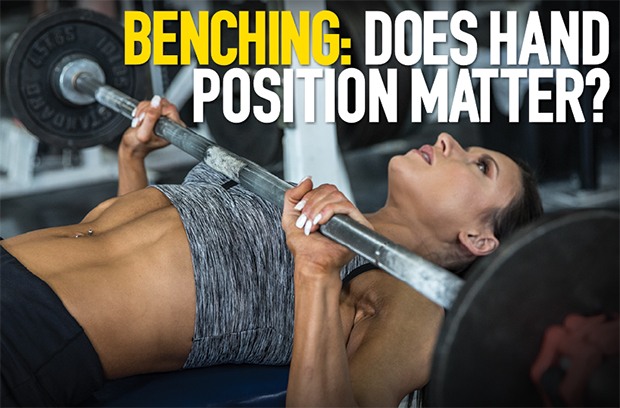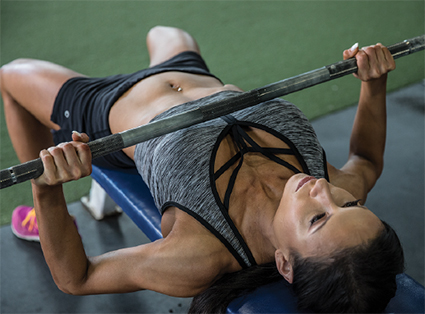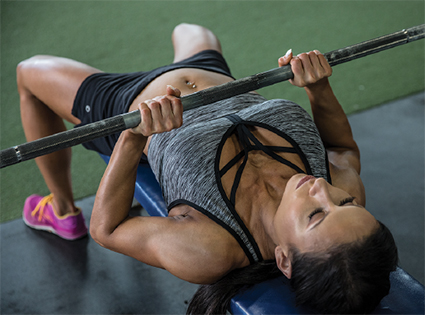Benches: Does Hand Position Matter?

Moving your hands in or out on the barbell can help you improve overall chest development
Once you’ve been training for a while, nothing’s easier than putting your workout on autopilot and cruising right through your routine with nary a thought as to what you’re doing. In fact, on an exercise as basic as the bench press, few consider something as simple as hand placement, let alone the rationale behind the choice. They just do it the way they do it, well, because that’s the way they always have.
But with all the attention Muscle Insiderhas focused lately on about making changes in your workout, even incremental ones, it’s time to consider just how your hand position on the bench press affects muscle recruitment.
 Let’s start with where you normally position your hands for a bench press. Likely, it’s outside shoulder width (it’d betterbe outside shoulder width!), but just how far is a matter of personal comfort. Personally, I use a hand position in which my forearms are completely perpendicular to the floor when the bar is in the down position; from here, with the elbows stacked directly under the hands, you simply push straight up against gravity. The problem with a wider or closer grip from this bottom position is simply that in either of those cases, there’s a lot of wasted energy because you’re no longer pushing just straight up. It’s less efficient to be pushing up and out (as in a wider hand position) or up and in (closer hand position). It’s not that you want to be pushing outward or inward—you don’t—it’s just that you’re forced to based on your hand position on the bar.
Let’s start with where you normally position your hands for a bench press. Likely, it’s outside shoulder width (it’d betterbe outside shoulder width!), but just how far is a matter of personal comfort. Personally, I use a hand position in which my forearms are completely perpendicular to the floor when the bar is in the down position; from here, with the elbows stacked directly under the hands, you simply push straight up against gravity. The problem with a wider or closer grip from this bottom position is simply that in either of those cases, there’s a lot of wasted energy because you’re no longer pushing just straight up. It’s less efficient to be pushing up and out (as in a wider hand position) or up and in (closer hand position). It’s not that you want to be pushing outward or inward—you don’t—it’s just that you’re forced to based on your hand position on the bar.
Inefficiencies aside, there are some valid reasons to use alternative hand positions, but they have more to do with altering the points of maximal stimulation on your chest as well as dialing up (and down) the contribution of secondary muscle groups (triceps, front delts) rather than maximizing bench-press strength.
 A closer grip on the bar reminds us of one common bench-press variation, the aptly named close-grip bench press. Because the hand position requires the elbow extensors to go through a longer range of motion here, the triceps become more heavily engaged; hence, it’s most often thought of as a multi-joint triceps exercise. You see that most clearly by watching how your elbows draw closer to your sides when using the closer grip, which means emphasis is being reduced on the pectorals. But that’s not all: The inner pec fibres are also better targeted with this variation, and the range of motion of the movement is now much longer. Remember, there’s no added benefit to continuing to move your grip inward until your hands touch; it is uncomfortable on your wrists, makes the bar more difficult to balance, and doesn’t result in any further triceps stimulation. About 8 to 12 inches apart is good for most people on close-grip benches.
A closer grip on the bar reminds us of one common bench-press variation, the aptly named close-grip bench press. Because the hand position requires the elbow extensors to go through a longer range of motion here, the triceps become more heavily engaged; hence, it’s most often thought of as a multi-joint triceps exercise. You see that most clearly by watching how your elbows draw closer to your sides when using the closer grip, which means emphasis is being reduced on the pectorals. But that’s not all: The inner pec fibres are also better targeted with this variation, and the range of motion of the movement is now much longer. Remember, there’s no added benefit to continuing to move your grip inward until your hands touch; it is uncomfortable on your wrists, makes the bar more difficult to balance, and doesn’t result in any further triceps stimulation. About 8 to 12 inches apart is good for most people on close-grip benches.
 Take a wider grip on the bar and note how the degree of bend in your elbows is now much reduced. You’d be correct, then, to suggest this variation highly reduces triceps engagement. In fact, the overall ROM has been reduced quite significantly. The point of maximal emphasis now shifts to your outer pecs, and there’s far more emphasis on those delts.
Take a wider grip on the bar and note how the degree of bend in your elbows is now much reduced. You’d be correct, then, to suggest this variation highly reduces triceps engagement. In fact, the overall ROM has been reduced quite significantly. The point of maximal emphasis now shifts to your outer pecs, and there’s far more emphasis on those delts.
No question, there is more or less one grip that’s best for optimizing overall bench-press strength, but you’d be wise to include variations that include any number of different close- and wide-grip hand positions to more thoroughly work the musculature for better overall gains in strength and size.
Get articles like this one delivered to your email each month by signing up for Muscle Insider’s mailing list. Just click here.

